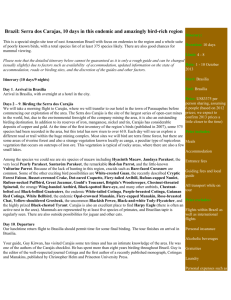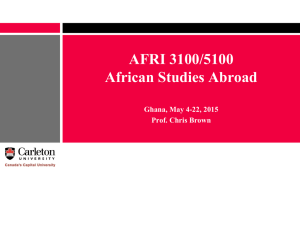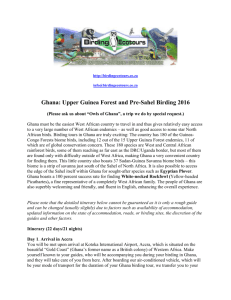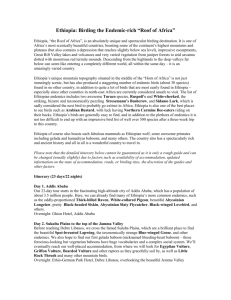16-day Ghana Birding Spectacular – Coastal
advertisement
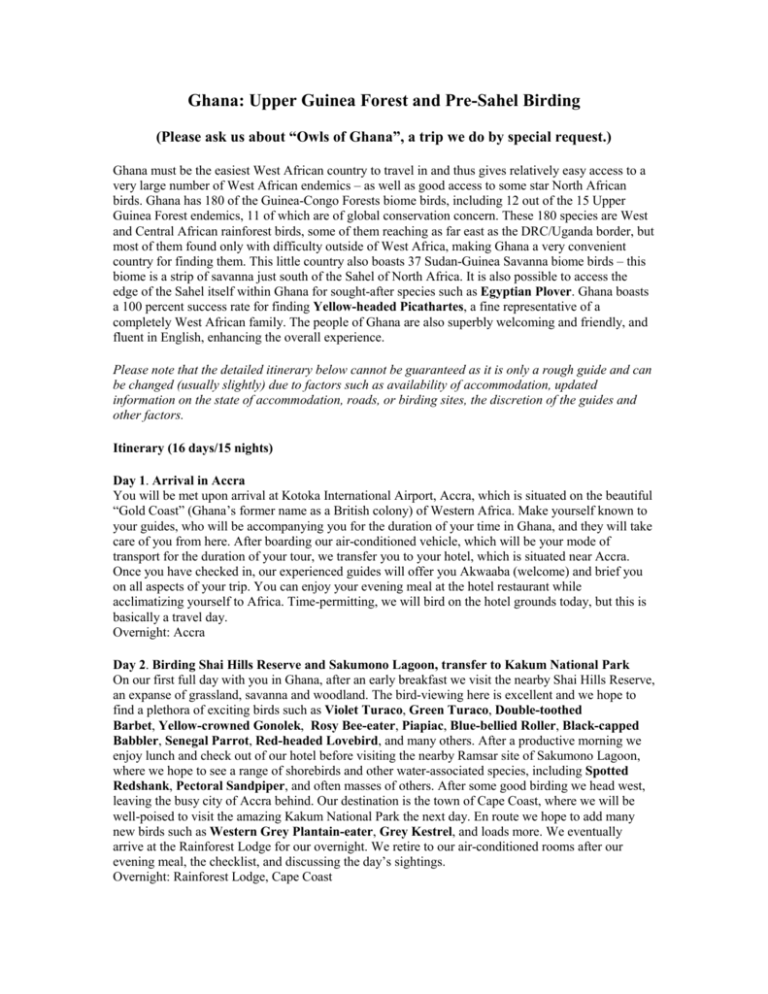
Ghana: Upper Guinea Forest and Pre-Sahel Birding (Please ask us about “Owls of Ghana”, a trip we do by special request.) Ghana must be the easiest West African country to travel in and thus gives relatively easy access to a very large number of West African endemics – as well as good access to some star North African birds. Ghana has 180 of the Guinea-Congo Forests biome birds, including 12 out of the 15 Upper Guinea Forest endemics, 11 of which are of global conservation concern. These 180 species are West and Central African rainforest birds, some of them reaching as far east as the DRC/Uganda border, but most of them found only with difficulty outside of West Africa, making Ghana a very convenient country for finding them. This little country also boasts 37 Sudan-Guinea Savanna biome birds – this biome is a strip of savanna just south of the Sahel of North Africa. It is also possible to access the edge of the Sahel itself within Ghana for sought-after species such as Egyptian Plover. Ghana boasts a 100 percent success rate for finding Yellow-headed Picathartes, a fine representative of a completely West African family. The people of Ghana are also superbly welcoming and friendly, and fluent in English, enhancing the overall experience. Please note that the detailed itinerary below cannot be guaranteed as it is only a rough guide and can be changed (usually slightly) due to factors such as availability of accommodation, updated information on the state of accommodation, roads, or birding sites, the discretion of the guides and other factors. Itinerary (16 days/15 nights) Day 1. Arrival in Accra You will be met upon arrival at Kotoka International Airport, Accra, which is situated on the beautiful “Gold Coast” (Ghana’s former name as a British colony) of Western Africa. Make yourself known to your guides, who will be accompanying you for the duration of your time in Ghana, and they will take care of you from here. After boarding our air-conditioned vehicle, which will be your mode of transport for the duration of your tour, we transfer you to your hotel, which is situated near Accra. Once you have checked in, our experienced guides will offer you Akwaaba (welcome) and brief you on all aspects of your trip. You can enjoy your evening meal at the hotel restaurant while acclimatizing yourself to Africa. Time-permitting, we will bird on the hotel grounds today, but this is basically a travel day. Overnight: Accra Day 2. Birding Shai Hills Reserve and Sakumono Lagoon, transfer to Kakum National Park On our first full day with you in Ghana, after an early breakfast we visit the nearby Shai Hills Reserve, an expanse of grassland, savanna and woodland. The bird-viewing here is excellent and we hope to find a plethora of exciting birds such as Violet Turaco, Green Turaco, Double-toothed Barbet, Yellow-crowned Gonolek, Rosy Bee-eater, Piapiac, Blue-bellied Roller, Black-capped Babbler, Senegal Parrot, Red-headed Lovebird, and many others. After a productive morning we enjoy lunch and check out of our hotel before visiting the nearby Ramsar site of Sakumono Lagoon, where we hope to see a range of shorebirds and other water-associated species, including Spotted Redshank, Pectoral Sandpiper, and often masses of others. After some good birding we head west, leaving the busy city of Accra behind. Our destination is the town of Cape Coast, where we will be well-poised to visit the amazing Kakum National Park the next day. En route we hope to add many new birds such as Western Grey Plantain-eater, Grey Kestrel, and loads more. We eventually arrive at the Rainforest Lodge for our overnight. We retire to our air-conditioned rooms after our evening meal, the checklist, and discussing the day’s sightings. Overnight: Rainforest Lodge, Cape Coast Day 3. Birding Kakum National Park After an early breakfast we head for the world famous canopy walkway at Kakum National Park, which is approximately a 15-minute drive from our lodge. We aim to get there for first light birding, 40 meters above the forest floor. The 360 km² Kakum National Park protects secondary Upper Guinea tropical rainforest, and the species we hope to see from the canopy include Congo Serpent Eagle, Long-tailed Hawk, Blue Cuckooshrike, Sabine’s Puffback, Sharpe’s Apalis, beautiful Golden-backed Weaver, at least two malimbe species, a host of Sunbirds including the beautiful and unique Buff-throated, Green Hylia, Violet-backed Hyliota, Chestnut-capped Flycatcher, Usher’s Flycatcher, three different negritas, Grey Longbill, beautiful White-headed and Forest Wood Hoopoes, Rufous-crowned Eremomela, several Barbets including Yellowspotted and Hairy-Breasted, Red-fronted Parrot, African Grey Parrot, and so many others! We then have lunch at our hotel, and during the heat of the day you can either rest (recommended) or the guide can take you birding. We re-visit the canopy in the evening, when our main targets will be Brown-cheeked Hornbill, the massive Wattled Hornbills (two species, Black-casqued and Yellow-casqued), Brown Nightjar, and Fraser’s Eagle-Owl, amongst other specials. Our evening will be spent at the hotel restaurant and bar discussing the day’s sightings, adding to our checklist, and enjoying the atmosphere of our surroundings. Overnight: Rainforest Lodge, Cape Coast Day 4. Birding Kakum National Park This morning we will visit the Antwikwaa section of Kakum National Park, hoping to add some amazing birds to our growing list – White-throated Bee-eater, Rosy Bee-eater, Black Beeeater, Blue-throated Roller, Piping Hornbill, Red-rumped Tinkerbird, White-spotted Flufftail, Cassin’s Spinetail, Sabine’s Spinetail, and many others. We then go to a river site for the beautiful White-bibbed (White-throated Blue) Swallow, Preuss’s Cliff Swallow, Rock Pratincole, White-headed Lapwing, and other water-associated birds. In the afternoon we will concentrate our attention on the many trails within and surrounding the park, which should prove to be very productive. We hope to find White-tailed Alethe, Red-tailed Bristlebill, Grey-headed Bristlebill, Black Dwarf Hornbill, Red-billed Dwarf Hornbill, Olive Long-tailed Cuckoo, Forest Robin, Yellow-billed Turaco, Fire-bellied Woodpecker, Melancholy Woodpecker, and so many others. Overnight: Rainforest Lodge, Cape Coast Day 5. Transfer to Ankasa National Park Another early start this morning as we visit a different section of Kakum National Park, hoping to see species we may have missed previously. Our main targets will be Red-billed Helmetshrike, Blackbellied Seedcracker, Forest Penduline Tit, Rufous-sided Broadbill, Western Bluebill, Blackwinged Oriole, Purple-throated Cuckooshrike, various Cuckoos including Yellow-throated, and Willcocks’s Honeyguide. We leave after the morning birding session and set off for Ankasa Conservation Area in the extreme western region of Ghana for what should be a major highlight of your time with us. Ankasa is Ghana’s only pristine wet evergreen Upper Guinea rainforest. We arrive in the afternoon, check into our accommodation and have lunch before heading out for early evening birding. We hope to see one of Africa’s most sought-after but rarely seen owls, Akun Eagle-Owl. We have two nights of fully-equipped camping right at the best birding part of Ankasa. We camp here instead of staying at the only accommodation in the region, which is awful. Overnight: Campsite, Ankasa National Park Days 6 – 7. Birding Ankasa National Park Amazing Ankasa! We hope to find Hartlaub’s Duck, African Finfoot, Dwarf Bittern, Crowned Eagle, Great Blue Turaco, Yellow-billed Turaco, and many others. Stops at pools should yield White-bellied Kingfisher as well as Shining Blue Kingfisher, and Chocolate-backed Kingfisher can be found away from water. We’ll also try for Rufous-winged Illadopsis, Brown Illadopsis, a host of greenbuls, Red-fronted Antpecker, and more. We’ll try our best for Nkulengu Rail. Overnight: Campsite, Ankasa National Park Day 8. Birding Aboabo, searching for Yellow-headed Picathartes, transfer to Kumasi An early start (like most days) as we head towards Aboabo on the north-eastern border of Kakum National Park. We arrive early to make the most of our time here; Aboabo is arguably the most productive section of Kakum National Park and the birdlife here rarely disappoints. We take a packed lunch with us, which will allow us to dedicate the whole morning trying to add more species to our rapidly growing list. We hope to see African Piculet, Black-capped Apalis, Black-throated Coucal, Red-vented Malimbe, Crested Malimbe, Western Nicator, Swamp Palm Bulbul, Redbellied Paradise Flycatcher, and hopefully Tessmann’s Flycatcher. After enjoying our packed lunch, we set off for a remote village. On our arrival, we trek into a nearby forest – our destination is a nesting site for one of the most sought-after birds in the world, the prehistoric-looking Yellow-headed Picathartes! There are around 30 nests at this location, and catching a glimpse of this remarkable bird is an amazing feeling. Once everyone has enjoyed good views, we set off for Kumasi, capital of the Ashanti region. On arrival, we check into our hotel and enjoy a cold drink over our evening meal while reflecting on one of the most memorable birding days of our lives. Overnight: Kumasi Day 9. Transfer to Mole National Park Today we enter a completely different habitat full of completely new birds! We leave Kumasi early after breakfast, heading north towards Mole National Park. We can expect to see a host of different bird species en route as we gradually enter the broad-leaf dry Guinea woodland and savanna plains of northern Ghana. On our arrival at Mole National Park, we check into the Mole Hotel, which is the only accommodation in the area. Situated on a 250 meter high escarpment overlooking this 4840km² park, it offers breathtaking views. It is an amazing feeling to be sitting around the pool on the hotel terrace and watching African savanna elephants bathing in the two nearby watering holes, which are inhabited by crocodiles. After our evening meal, we shall set off for an evening of birding around the Mole airstrip, where we hope to see displaying Standard-winged Nightjar and other night birds Overnight: Mole Hotel. Days 10 – 11, Birding Mole National Park Over the next two days we will be setting off early after breakfast, walking in different sections of the park. During our time here we hope to see Oriole Warbler, Chestnut-crowned Sparrow-Weaver, Lavender Waxbill, Orange-cheeked Waxbill, Red-throated Bee-eater, Brown-backed Woodpecker, Grey Woodpecker, Fine-spotted Woodpecker, Senegal Batis, various firefinches, the unusual Stone Partridge, Beautiful Sunbird, Pygmy Sunbird, Abyssinian Ground Hornbill, and a long list of other tantalizing species. Raptors are abundant. We’ll make excursions for specific birds such as Spotted Creeper, various lark species, Forbes’s Plover, and more. Pel’s Fishing Owl will sometimes put in an appearance. Overnight: Mole Hotel Day 12. Transfer to Bolgatanga, birding at Tongo Hills After a final morning birding on the terrace of the hotel and a hearty breakfast, we depart for Bolgatanga in the Upper East Region. As we venture northwards, the landscape becomes even drier. We pass through many villages and stop at Tamale for lunch and refreshments. Tamale is Ghana’s third-largest city and is the capital of the Northern Region. We arrive in Bolgatanga in the afternoon and check into our guesthouse before setting off for late afternoon birding at the Tongo Hills. Here some of our main target species will be Fox Kestrel, Rock-loving Cisticola, White-crowned Cliff Chat, and Cinnamon-breasted Rock Bunting. Overnight: Bolgatanga Day 13. Birding at Tono Dam, searching for Egyptian Plover We’ll have an early start as we watch the dawn activity around the Tono Dam. We hope to find a variety of egrets, waders, and herons, as well as Cut-throat Finch, African Silverbill, Red-winged Pytilia, Black-bellied Firefinch, Northern Carmine Bee-eater, the beautiful Abyssinian Roller, Four-banded Sandgrouse, and, as always, tons of others. In the afternoon, after a hearty lunch, we prepare ourselves for another major highlight of our tour as we set off towards a site for the beautiful Egyptian Plover, which has recently been declared a family of its own. We dedicate the afternoon to birding the river and surrounding habitat, also hoping to find the scarce and attractive Black-crowned Lapwing, White-billed Buffalo Weaver, and many more. Overnight en route to Kumasi (please note that we have lots of ground to cover on this tour and sometimes driving distances are quite long). Day 14. Transfer to Kumasi After breakfast we set off for Kumasi again, retracing our journey of a few days earlier. En route we will stop for lunch and to stretch our legs. Before we set off on our final journey to Kumasi; we hope to spot some different species during our drive. On our arrival we will relax, enjoy our evening meal, and prepare ourselves for an early start the following morning. This is basically a travel day as we have some distance to cover. Overnight: Kumasi Day 15. Birding the Bobiri Butterfly Sanctuary and Atewa Range Forest Reserve We wake early to visit Bobiri Butterfly Sanctuary. Upon our arrival, we will search this lush forest for Tit Hylia, Afep Pigeon, Western Bronze-naped Pigeon, Yellow-footed Honeyguide, Forest Francolin, Golden Greenbul, and rainforest birds we might have missed previously. With luck, we might see Long-tailed Hawk. In the afternoon, we will start birding the Atewa Range Forest Reserve, where we might find Buffspotted Woodpecker, Blue-headed Coucal, Black-bellied Seedcracker, Compact Weaver, Redcheeked Wattle-eye, and with luck Baumann’s Olive Greenbul. After a hopefully highly productive day of birding, we set off to our nearby guesthouse, enjoy our evening meal and discuss the day’s sightings after our checklist. Day 16. Birding the Atewa Range Forest Reserve, departure An early start this morning as we dedicate the early part of the day to the Atewa Range Forest Reserve. This is the main site in Ghana where we can see the endangered Rufous-winged Illadopsis, Nimba Flycatcher, and Blue-headed Bee-eater, but we expect to see many other birds here as well. Usually Atewa Range makes for a fantastic ending to a great tour! In the afternoon we head to the Accra airport for our flights out of the country. Duration: 16 days Limit: 4 - 8 Date: 1 – 16 March 2014 Start: Accra End: Accra Price: £2978 if 6 participants or £3324 if 4 participants. Single supplement £325. (These are 2013 prices; 2014 prices are expected to be 5 – 10% higher.) Price includes: Accommodation (Please note that there are three nights of fully-equipped camping in Ankasa National Park, since the only accommodation in the area is shockingly bad. Accommodation on this tour can be more basic than on most of our tours, but we generally use the best places available and stay as close to where the birds are as possible.) Airport transfer All meals: breakfast, lunch, dinner and snacks International tour leader and local guide Mineral water Park entrance fees All guide fees Excursion costs Professional care and attention Transportation in and around Ghana Fuel Price excludes: Flights Travel insurance Ghana entry visas Soft and alcoholic drinks Gratuities Gifts and other items of a purely personal nature
